Canada Electric Vehicle Battery Anode Market Size
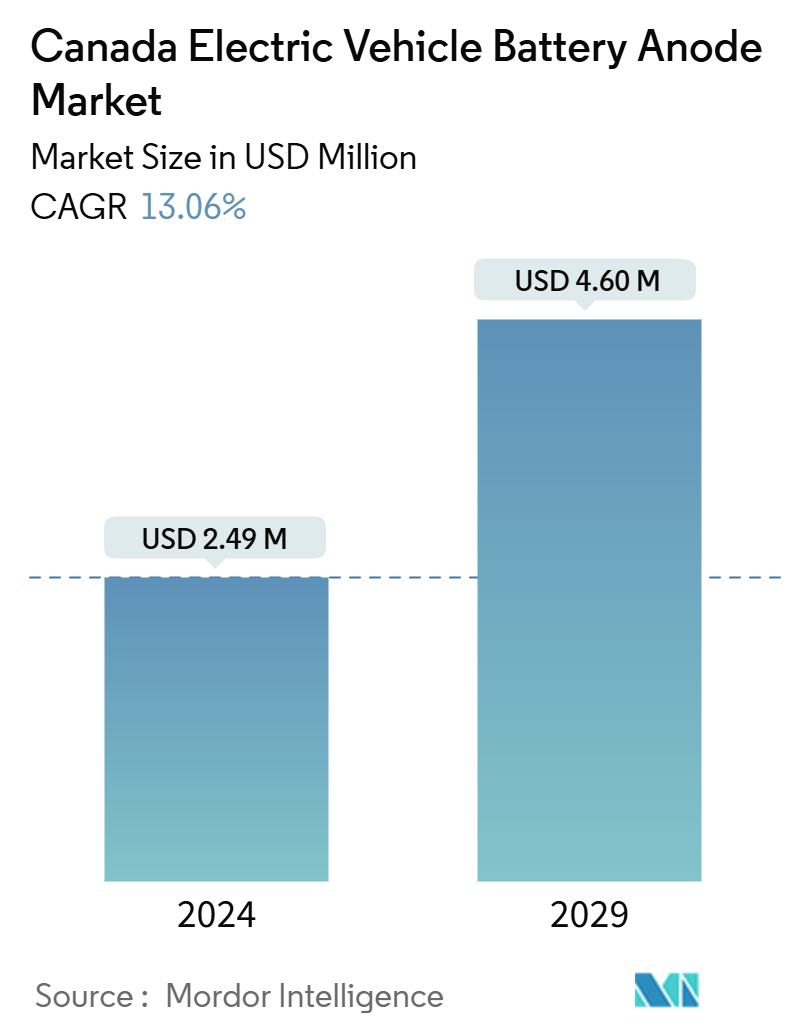
| Study Period | 2019 - 2029 |
| Base Year For Estimation | 2023 |
| Market Size (2024) | USD 2.49 Million |
| Market Size (2029) | USD 4.60 Million |
| CAGR (2024 - 2029) | 13.06 % |
| Market Concentration | High |
Major Players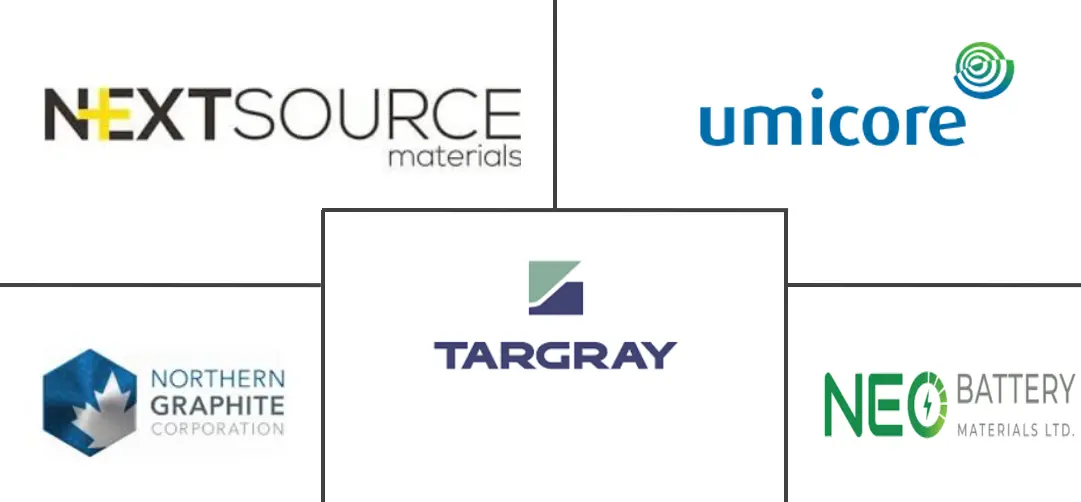
*Disclaimer: Major Players sorted in no particular order |
Canada Electric Vehicle Battery Anode Market Analysis
The Canada Electric Vehicle Battery Anode Market size is estimated at USD 2.49 million in 2024, and is expected to reach USD 4.60 million by 2029, at a CAGR of 13.06% during the forecast period (2024-2029).
- In the coming years, the Canada Electric Vehicle Battery Anode Market is poised for growth, driven by factors such as the rising adoption of electric vehicles, decreasing costs of Li-ion battery raw materials, and supportive government policies.
- Conversely, challenges like limited raw material reserves and existing supply chain gaps may hinder the market's expansion.
- However, with ongoing technological advancements in battery materials and Canada's ambitious long-term targets for electric vehicles, significant opportunities await players in the market.
Canada Electric Vehicle Battery Anode Market Trends
Lithium-ion Battery Segment to Dominate the Market
- Initially, the lithium-ion battery industry in Canada primarily served the consumer electronics sector. However, a significant transformation occurred over time. Electric vehicle (EV) manufacturers began to eclipse the consumer electronics sector, emerging as the dominant consumers of lithium-ion batteries, outpacing lead-acid and other battery types. This shift was predominantly fueled by the surging sales of EVs in Canada.
- In recent decades, Canada has witnessed a meteoric rise of lithium-ion battery technology, with its primary application being in the automotive sector. The United Kingdom is seeing a surge in the popularity of lithium-ion rechargeable batteries, mainly due to their superior capacity-to-weight ratio. Furthermore, lithium batteries in EVs do not emit NOX, CO2, or any other greenhouse gases, resulting in a significantly lower environmental impact compared to conventional internal combustion engine (ICE) vehicles. Leveraging this advantage, countries like Canada are actively promoting the adoption of EVs and fostering the growth of the battery anode manufacturing market.
- In April 2024, Honda announced its ambitious plans to set up an electric vehicle (EV) supply chain in Ontario, Canada. This initiative includes building an electric car production facility, a dedicated lithium-ion (Li-ion) battery facility, and two additional battery plants in partnership with Asahi Kasei and Posco. Honda's total investment in this venture is a staggering USD 11 billion, signaling a robust growth potential for players in the Electric Vehicle Battery Anode Market in Canada.
- According to the International Energy Agency (IEA), Battery Electric Vehicles (BEVs), which are predominantly powered by Li-ion technology, saw sales in Canada reach 130,000 in 2023, up from 91,000 in 2022. This represents a remarkable growth rate of 42.8% for Li-ion technology EVs, underscoring the segment's dominance in the Canadian Electric Vehicle Battery Anode Market.
- Additionally, the Plug-In Hybrid Electric Vehicle (PHEV) battery market in Canada, where anode material plays a crucial and in-demand role, also witnessed growth. PHEV sales, again dominated by Li-ion technology, rose from 24,000 vehicles in 2022 to 41,000 in 2023, as reported by the International Energy Agency (IEA).
- Given these insights, it's evident that the lithium-ion battery segment is poised to dominate the Canadian Electric Vehicle Battery Anode Market.
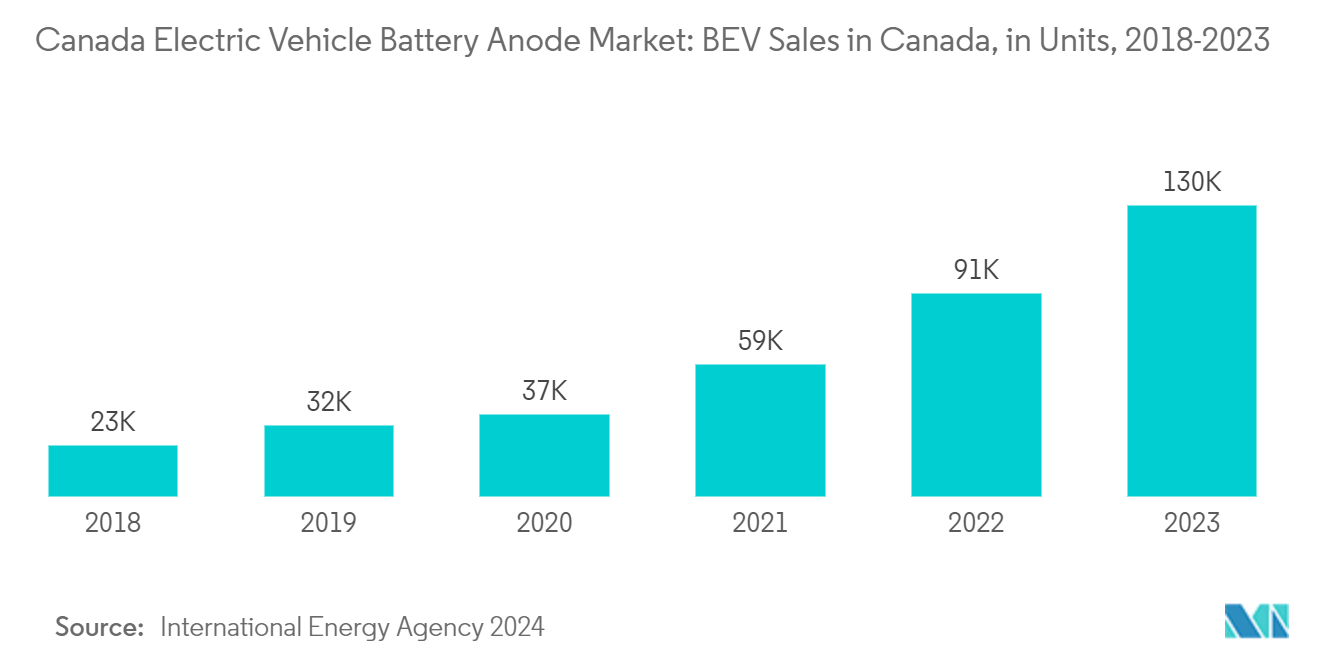
Policies and incentives of the Canadian Government are Driving the Market
- As part of the Paris Agreement and the United Nations SDGs (Sustainable Development Goals), the Government of Canada has committed to reducing GHG emissions on global platforms. To bolster the adoption of Electric Vehicles (EVs) and position Canada as a global hub for EV battery manufacturing, the government has introduced rebates, incentives, and import concessions targeting players in the electric vehicle batteries and associated anode markets.
- In its pursuit of becoming a key player in the EV battery sector, the Canadian government is intensifying efforts to secure critical minerals essential for manufacturing Electric Vehicle Battery Anodes. For instance, in December 2022, Canada took the lead in establishing the Sustainable Critical Minerals Alliance (SCMA). The SCMA's mission is to champion responsible global supply chains for critical minerals, underscoring the importance of environmentally sustainable, socially inclusive, and ethical practices in mining, processing, and recycling. This initiative resonates with the G7's 2030 Nature Compact commitment to halt and reverse biodiversity loss by 2030. The Alliance focuses on key minerals like graphite, lithium, and silicon, all of which are crucial for EV battery anode production.
- In December 2022, Canada rolled out its Critical Minerals Strategy, targeting the enhancement of the EV Battery and related materials market. This strategy underscores the importance of capitalizing on opportunities throughout the entire value chain, with an aim to establish Canada as a leading global supplier of critical minerals.
- Responding to the global decline in lithium-ion battery pack prices, the Canadian government is taking note. Data from Bloomberg NEF indicates that in 2023, average battery pack prices for electric vehicles (EVs) fell to USD 139/kWh, a significant 13% drop from 2022. This decline followed a trend of rising prices in the years prior. With ongoing technological advancements and improved manufacturing efficiencies, projections suggest a continued decrease in battery pack prices, further bolstering the growth of the Electric Vehicle Battery Anode Market in Canada.
- The Canadian government is also prioritizing the expansion of electric vehicle charging stations across the country. The International Energy Agency's Global EV Outlook highlights that the number of EV charging points in Canada grew from 20,900 in 2022 to 26,800 in 2023, including 10,000 Superfast EV charging stations. This expansion not only boosts EV adoption in Canada but also drives demand for EV battery anodes.
- Encouraged by favorable government policies, many companies are setting up operations in Canada. A notable example is Umicore NV, a global frontrunner in EV battery anode production, which in October 2023, announced the expansion of its facilities in Ontario, Canada, introducing new CAM and pCAM plants.
- These developments underscore the Canadian government's concerted efforts to nurture and expand the Electric Vehicle Battery Anode Market within its borders.
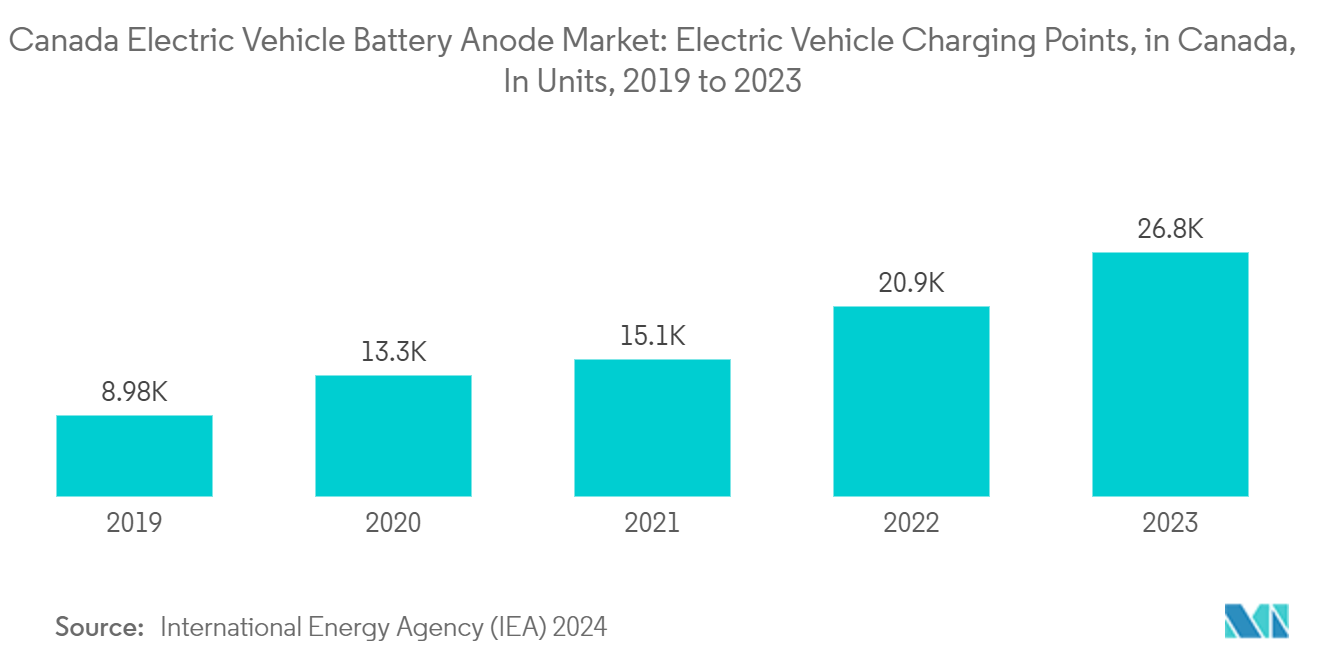
Canada Electric Vehicle Battery Anode Industry Overview
The Canada Electric Vehicle Battery Anode Market is consolidated. Some of the major players in the market (in no particular order) include NextSource Materials Inc., Umicore N.V., Northern Graphite Corporation, NEO Battery Materials LTD, and Targray Technology International Inc., among others.
Canada Electric Vehicle Battery Anode Market Leaders
-
Umicore N.V.
-
Northern Graphite Corporation
-
NEO Battery Materials LTD
-
NextSource Materials Inc.
-
Targray Technology International Inc.
*Disclaimer: Major Players sorted in no particular order
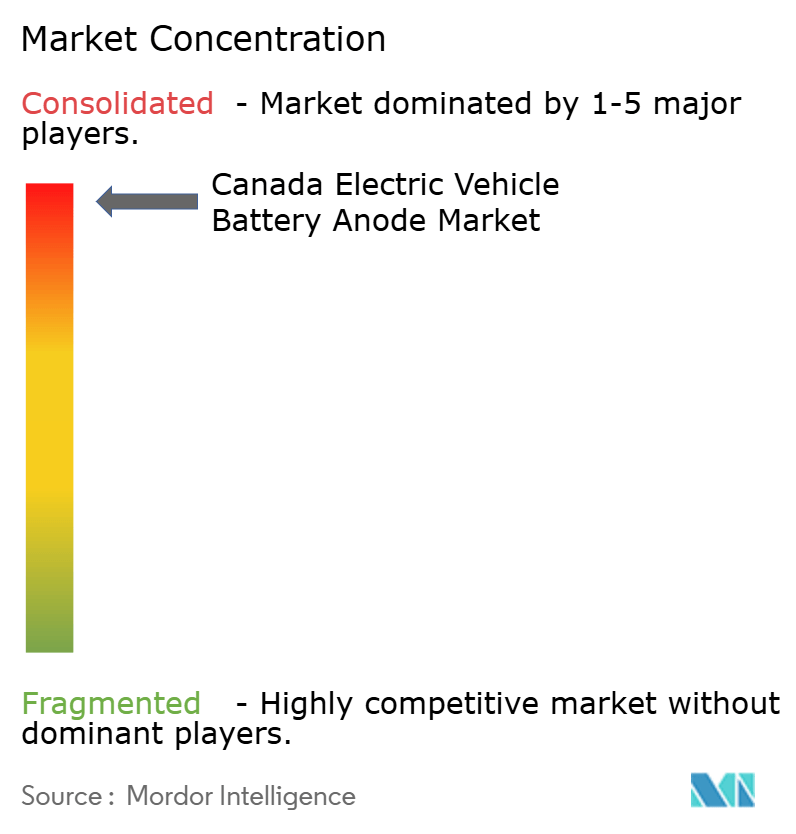
Canada Electric Vehicle Battery Anode Market News
- June 2024: Northern Graphite Corp., based in Ontario, has announced its intention to set up an EV battery anode manufacturing plant in Canada by 2026. The company has chosen Quebec as the site for its new facility and will procure graphite from both Ontario and Quebec. Northern Graphite aims to achieve an annual production capacity of 200,000 tonnes of battery anode material.
- February 2024: Panasonic Energy has signed a seven-year offtake agreement with Nouveau Monde Graphite Inc. (NMG), a leading Canadian producer of anode active materials, to procure natural graphite. In addition, Panasonic Energy plans to invest in NMG, starting with an initial investment of USD 25 million. This partnership underscores Panasonic Energy's commitment to enhancing its EV battery production in North America. A primary objective is to increase the utilization of locally sourced materials, fostering a sustainable supply chain in light of the growing global demand for EVs.
Canada Electric Vehicle Battery Anode Market Report - Table of Contents
1. INTRODUCTION
1.1 Scope of the Study
1.2 Market Definition
1.3 Study Assumptions
2. EXECUTIVE SUMMARY
3. RESEARCH METHODOLOGY
4. MARKET OVERVIEW
4.1 Introduction
4.2 Market Size and Demand Forecast in USD, till 2029
4.3 Recent Trends and Developments
4.4 Government Policies and Regulations
4.5 Market Dynamics
4.5.1 Drivers
4.5.1.1 The Growing Adoption of Electric Vehicles
4.5.1.2 Favorable Government Policies
4.5.1.3 Decreasing Price of Lithium-ion Batteries
4.5.2 Restraints
4.5.2.1 The Supply Chain Gap
4.6 Supply Chain Analysis
4.7 Pestle Analysis
4.8 Investment Analysis
5. MARKET SEGMENTATION
5.1 By Battery type
5.1.1 Lithium-ion
5.1.2 Lead-acid
5.1.3 Other Battery Types
5.2 By Material Type
5.2.1 Silicon
5.2.2 Graphite
5.2.3 Lithium
5.2.4 Other Materials
6. COMPETITIVE LANDSCAPE
6.1 Mergers and Acquisitions, Joint Ventures, Collaborations, and Agreements
6.2 Strategies Adopted by Leading Players
6.3 Company Profiles
6.3.1 Nouveau Monde Graphite Inc.
6.3.2 NextSource Materials Inc.
6.3.3 Nanode Battery Technologies
6.3.4 Umicore N.V.,
6.3.5 Northern Graphite Corporation
6.3.6 Panasonic Corporation
6.3.7 Targray Technology International Inc.
6.3.8 NEO Battery Materials LTD
6.3.9 Echion Technologies Limited
- *List Not Exhaustive
6.4 List of Other Prominent Companies
6.5 Market Ranking/Share (%) Analysis
7. MARKET OPPORTUNITIES AND FUTURE TRENDS
7.1 Ongoing Research and Advancement in Anode Material
Canada Electric Vehicle Battery Anode Industry Segmentation
The anode, a crucial component of an EV battery, serves as the negative electrode. Typically crafted from a metal that oxidizes, it transfers electrons to the cathode, the battery's positive electrode. This electrochemical reaction generates the electricity that powers the electric vehicle. In lithium-ion batteries, the predominant type used in EVs, the anode is commonly composed of graphite.
The Canada electric vehicle battery anode market is segmented by battery type and material. By battery type, the market is segmented into lithium-ion batteries, lead-acid batteries, and other battery type. By material, the market is segmented into lithium, graphite, silicon, and others.
The Report Offers the Market Size and Forecasts for the Canada Electric Vehicle Battery Anode Market in Revenue (USD) for all the Above Segments.
| By Battery type | |
| Lithium-ion | |
| Lead-acid | |
| Other Battery Types |
| By Material Type | |
| Silicon | |
| Graphite | |
| Lithium | |
| Other Materials |
Canada Electric Vehicle Battery Anode Market Research FAQs
How big is the Canada Electric Vehicle Battery Anode Market?
The Canada Electric Vehicle Battery Anode Market size is expected to reach USD 2.49 million in 2024 and grow at a CAGR of 13.06% to reach USD 4.60 million by 2029.
What is the current Canada Electric Vehicle Battery Anode Market size?
In 2024, the Canada Electric Vehicle Battery Anode Market size is expected to reach USD 2.49 million.
Who are the key players in Canada Electric Vehicle Battery Anode Market?
Umicore N.V., Northern Graphite Corporation, NEO Battery Materials LTD, NextSource Materials Inc. and Targray Technology International Inc. are the major companies operating in the Canada Electric Vehicle Battery Anode Market.
What years does this Canada Electric Vehicle Battery Anode Market cover, and what was the market size in 2023?
In 2023, the Canada Electric Vehicle Battery Anode Market size was estimated at USD 2.16 million. The report covers the Canada Electric Vehicle Battery Anode Market historical market size for years: 2019, 2020, 2021, 2022 and 2023. The report also forecasts the Canada Electric Vehicle Battery Anode Market size for years: 2024, 2025, 2026, 2027, 2028 and 2029.
Canada Electric Vehicle Battery Anode Industry Report
Statistics for the 2024 Canada Electric Vehicle Battery Anode market share, size and revenue growth rate, created by Mordor Intelligence™ Industry Reports. Canada Electric Vehicle Battery Anode analysis includes a market forecast outlook for 2024 to 2029 and historical overview. Get a sample of this industry analysis as a free report PDF download.



